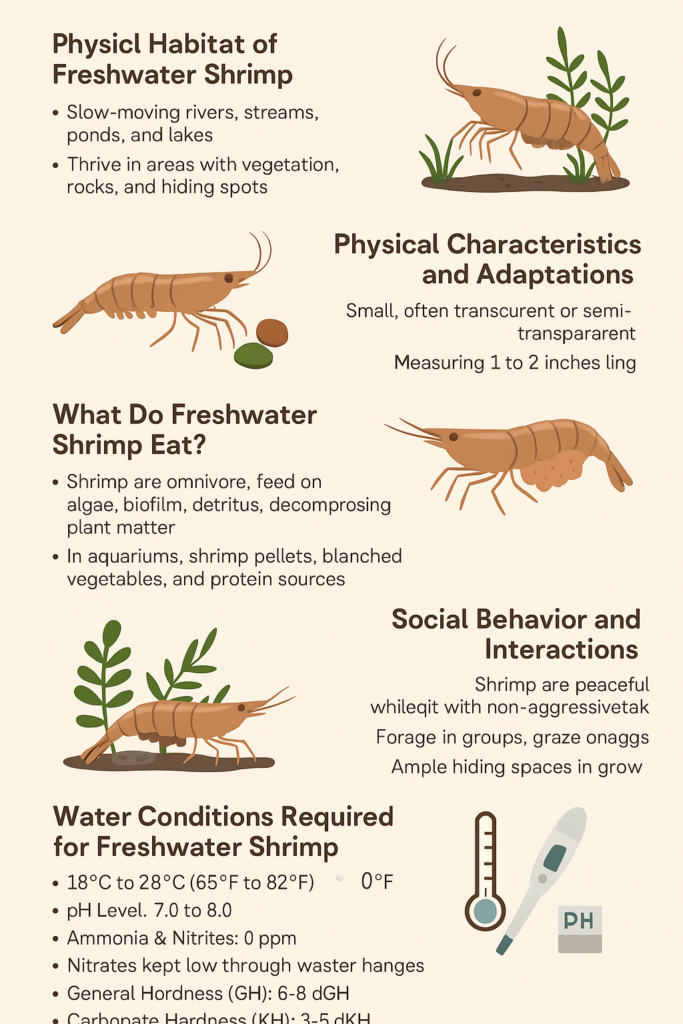How Do Freshwater Shrimps Live?
Freshwater shrimp are fascinating creatures that play a crucial role in aquatic ecosystems. They help maintain water quality by consuming algae and decomposing organic matter. Whether in the wild or an aquarium, these tiny invertebrates have specific habitat, diet, and environmental requirements that influence their survival and overall well-being.

Natural Habitat of Freshwater Shrimp
Freshwater shrimp are found in a variety of environments, including slow-moving rivers, streams, ponds, and lakes. They thrive in areas with abundant vegetation, rocks, and hiding spots that provide security from predators. The presence of live plants in their habitat is essential as it helps with oxygenation, provides shelter, and serves as a food source.
For instance, ghost shrimp prefer live plants such as hornwort, Cabomba, and java moss, which offer hiding places and promote algae growth for feeding. (Learn more)
Physical Characteristics and Adaptations
Most freshwater shrimp are small, measuring between 1 to 2 inches in length. Their bodies are often translucent or semi-transparent, allowing them to blend with their surroundings to avoid predators. They have a hard exoskeleton that protects them while allowing flexibility for movement. Shrimp regularly molt, shedding their exoskeleton as they grow.
What Do Freshwater Shrimp Eat?
Freshwater shrimp are omnivores and primarily feed on algae, biofilm, detritus, and decomposing plant matter. Their diet is essential for maintaining a balanced ecosystem. In an aquarium setting, they can be fed shrimp pellets, blanched vegetables, and high-quality protein sources such as bloodworms. Overfeeding can negatively affect water quality, so maintaining a proper feeding routine is crucial.
Cherry Red shrimp, for example, can eat bloodworms, but it’s advisable to feed them bloodworms sparingly to prevent health issues. (Learn more)
Social Behavior and Interactions
Freshwater shrimp are peaceful creatures that can coexist with other non-aggressive tank mates. They tend to forage in groups and can often be seen grazing on surfaces covered with algae. Providing ample hiding spaces with plants and decorations helps them feel secure and reduces stress.
When selecting aquarium mates, it’s essential to choose species that are compatible with freshwater shrimp to ensure a stress-free environment. (Learn more)
Reproduction and Life Cycle
The reproductive process varies depending on the species. Typically, female shrimp carry fertilized eggs under their abdomen until they hatch. The incubation period lasts about two to three weeks. Newly hatched shrimp resemble miniature adults and undergo multiple molting stages as they grow.
Crossbreeding different shrimp species requires knowledge of their genetics. For instance, Cherry shrimp and Bee shrimp cannot interbreed as they belong to different genera and species. (Learn more)
Water Conditions Required for Freshwater Shrimp
Maintaining the right water parameters is critical for freshwater shrimp to thrive. Here are key factors to monitor:
- Temperature: 18°C to 28°C (65°F to 82°F)
- pH Level: 7.0 to 8.0
- Ammonia & Nitrites: Should be at 0 ppm
- Nitrates: Should be kept low through water changes
- General Hardness (GH): 6-8 dGH
- Carbonate Hardness (KH): 3-5 dKH
Using a water testing kit ensures stable conditions, which is vital for shrimp health and longevity. For example, Cherry shrimp thrive in temperatures between 65°F to 80°F (18°C to 26°C), with an ideal range around 72°F to 78°F (22°C to 25°C). (Learn more)
If you’re setting up a shrimp tank for the first time, watching a visual guide can be extremely helpful. Check out this video for step-by-step instructions: How to Setup a Shrimp Tank
Common Health Issues and Prevention
Freshwater shrimp can experience health issues, often due to poor water conditions or malnutrition. Common problems include:
- Molting Issues: Caused by lack of calcium or unstable water conditions.
- Bacterial Infections: Symptoms include discoloration and lethargy.
- Parasites: Can attach to shrimp and cause health deterioration.
Regular water changes, a balanced diet, and maintaining proper tank conditions help prevent these issues. It’s also important to monitor shrimp behavior, as signs like laying on their back or side can indicate health problems. (Learn more)
How Long Do Freshwater Shrimp Live?
The lifespan of freshwater shrimp varies by species and environment. On average, they live between one to two years in captivity. However, optimal care, including proper feeding and stable water conditions, can extend their lifespan. For instance, ghost shrimp typically live for about one year. (Learn more)
Conclusion
Freshwater shrimp are resilient creatures that play an essential role in maintaining a balanced aquatic ecosystem. Their survival depends on stable water conditions, a nutritious diet, and a well-structured habitat. Whether in the wild or in an aquarium, understanding their needs ensures they thrive and contribute positively to their environment.
Resources
- How Long Can Ghost Shrimp Live in a Bag?
- Can Cherry Red Shrimp Eat Bloodworms?
- Aquarium Mates Selection for Freshwater Shrimp Setup
- Can Cherry Shrimp and Bee Shrimp Breed?
- What Are the Perfect Cherry Shrimp Water Parameters?
- Why Is Your Ghost Shrimp Laying on Its Back or Side?
- Can You Keep Ghost Shrimp in a Bowl?
External Resources
- Aquarium Co-Op – Guide to Freshwater Shrimp
- The Shrimp Farm – Freshwater Shrimp Care
- Planet Inverts – Shrimp Species Guide
Recent Posts
How Many Freshwater Shrimp Per Gallon? 4 Key Factors Freshwater shrimp are popular additions to aquariums, but many hobbyists wonder: how many shrimp can comfortably live in a gallon of water? The...
Why Are Some Shrimp So Colorful? 4 Reasons Shrimp are fascinating creatures that come in a variety of colors, ranging from transparent to vivid reds, blues, and greens. But what causes these...

